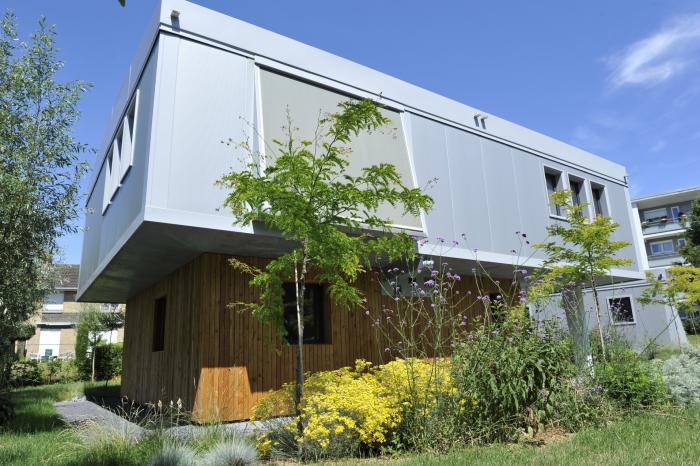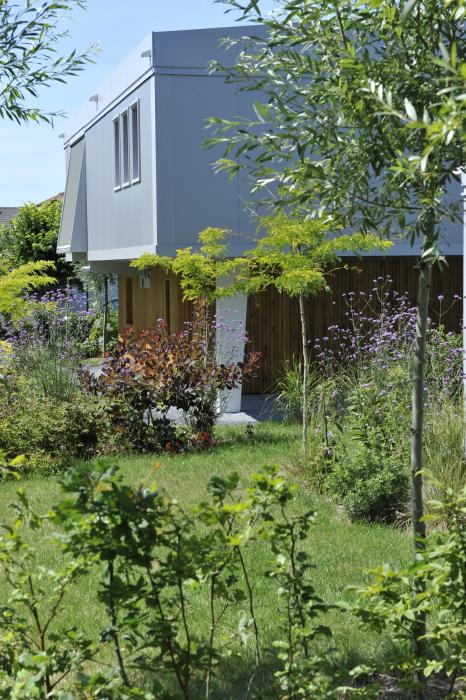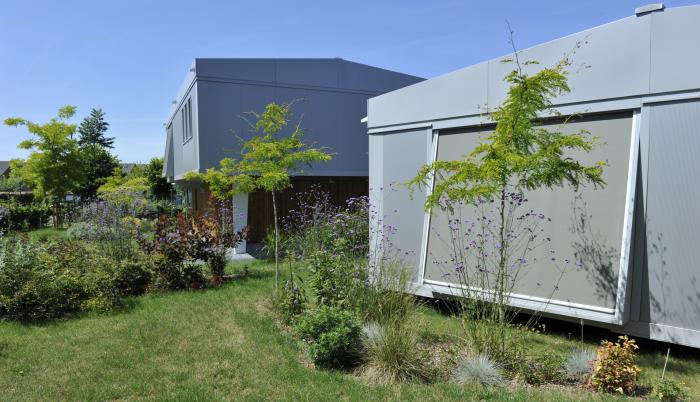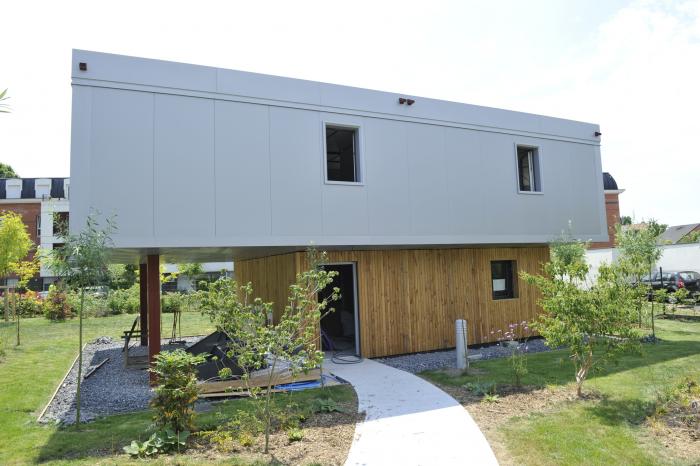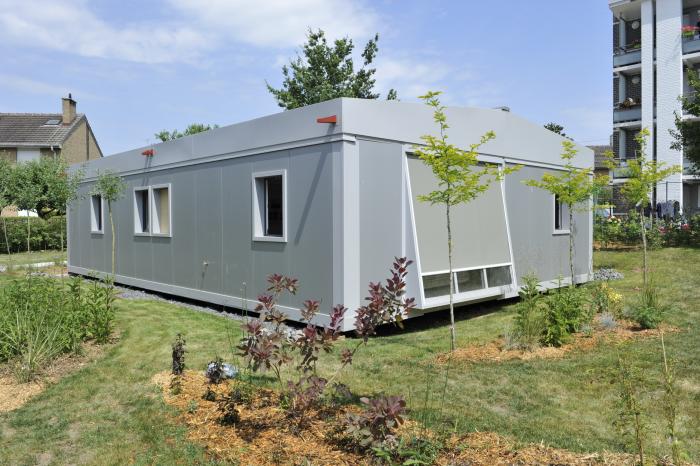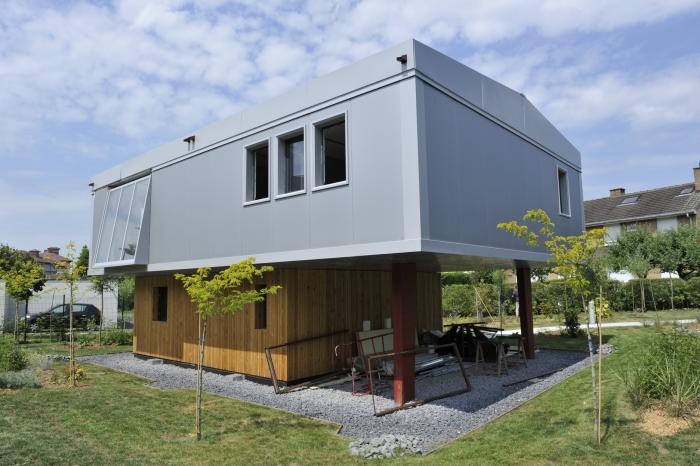I. SUMMARY INFORMATION
Project
268412
Status
Submitted
Award category
Techniques, materials and processes for construction and design
You want to submit
NEW EUROPEAN BAUHAUS AWARDS : existing completed examples
Project title
Metropole Evolution House
Full project title
Metropole Evolution House - Jean Prouvé revisited by Jean-Charles Huet, Project Owner Vilogia
Description
To respond to the urgent need to build affordable housing in large numbers, Vilogia, historic social landlord of the North of France, was inspired by what the brilliant engineer and architect Jean Prouvé had thought before everyone else: to build houses like we build cars. Two metal pavilions were built as prototypes and demonstrate that industrial design can be beautiful, affordable and sustainable.
Where was your project implemented in the EU?
France
Hauts de France
30 rue du 11 Novembre 1918
50°39'55.9"North
3°07'42.9"East
Wasquehal
59290
When was your project implemented?
Has your project benefited from EU programmes or funds?
No
Which programme(s) or fund(s)? Provide the name of the programme(s)/fund(s), the strand/action line as relevant and the year.
II. DESCRIPTION OF THE PROJECT
Please provide a summary of your project
In 1952, the CIL Roubaix-Tourcoing, future Vilogia, acquires 2 Métropole pavilions, prototypes created by Jean Prouvé, both engineer and architect. Its construction system is innovative and can be industrialized: made of light metal panels, these pavilions are quick to assemble, spacious and modular, and it meets the economic constraints of reconstruction. But "to be right too soon is to be wrong": this adventure will end there for lack of finding its audience ...
In the 21st century: history repeats itself: explosion in construction costs, financing issues, the urgency to respond to poor housing and to comply with environmental issues! In addition, society is changing, our lives are less and less sedentary and the composition of households is changing. At the same time, Do It Yourself have become essential, and it’s confirmed by the Covid crisis!
2016, inspired by these challenges and by these pavilions, Vilogia embarked on R&D work and produced 2 modular housing prototypes in kit form (one on one level and the other in 2 storeys), with the aim to launch mass production and market them as affordable home ownership.
It is about this project that we are going to talk about in this application.
Please give information about the key objectives of your project in terms of sustainability and how these have been met
Why metal houses?
1. Because when it comes to assembly, metal is the lightest material, even less than wood: the structure can be assembled by 3 people.
2. It is also ecological because it is recycled and endlessly recyclable.
3. The outer walls are standard modules, already existing in the industry, which optimizes the cost.
From an energy performance point of view, the pavilions consume less than 40kWh / m² / year, which is close to the Passivhaus level.
Please give information about the key objectives of your project in terms of aesthetics and quality of experience beyond functionality and how these have been met
Jean Prouvé is the great reference in terms of industrial design in Europe and around the world. His works, his furniture, his decorative objects are snapped up today in the auction rooms. The pavilions he built in the 1950s, two in Tourcoing and 12 in Meudon in the Paris region, are valued at more than one million euros each. The reference to this great artist contributes to a better understanding of the aesthetic.
Slightly out of date, the architecture of these pavilions is today considered to be an iconoclastic approach in relation to housing standards, but industrial construction is getting closer and closer to its concepts.
When you are inside, you immediately feel the care that has been put into the roominess and comfort. The large bow window with its 14 ° inclined plane which brings light and warmth, its sash windows, the modularity of the rooms which can evolve according to the needs of the household who lives there, the famous porthole door that could be exposed in a museum of modern art, the iconic compass-shaped portico, etc. All these elements contribute to the intrinsic beauty of the building.
All the housing is positioned upstairs, the ground floor being confined to technical functions. Thus, even from the living room, we dominate the surrounding gardens while being away from the humidity of the soil.
Please give information about the key objectives of your project in terms of inclusion and how these have been met
The principle of industrialization is cost reduction through massification. Once the first prototypes were developed, a list of elements that should be modified so as to be more easily industrialized was drawn up. The routing of the cables, the size of the modules, the choice of windows ... a lot of things remain to be done to reach the target cost that we have set for ourselves.
The principle is that a pavilion of 8 m by 8 m, i.e. 64m², which is equivalent to an accommodation consisting of a living room, a bathroom and two bedrooms, does not exceed € 50,000 excluding taxes, delivery and the cost of the land for its DIY version.
This unbeatable price can be achieved with the volume of production, relying as much as possible on standard elements, and minimizing the cost of labor.
In addition, the assembly of this pavilion can be completed in less than 3 weeks, which makes it eligible for emergency accommodation. With the Covid crisis, we are now seeing great needs for temporary accommodation flourish for seasonal workers and this pavilion could be one of the answers.
To be short, the inclusive side of this project therefore comes from both its affordability and the speed with which it is completed.
Please give information on the results/impacts achieved by your project in relation to the category you apply for
The strengths of these kits:
1. The workforce is very light (3 people only)
2. The construction time is short; 10 days are enough to complete the covered enclosure without lifting equipment, 20 days to be delivered,
3. Modularity is absolute:
a. Any exterior panel can optionally be blind, half-window or fully glazed
b. The interior design can be personalized according to the surface area and the number of rooms chosen
4. For equipment, no need to be a plumber or electrician, all equipment can be assembled like LEGO®.
5. The accommodation is energy label A and respects all standards including acoustics, disabled, etc ...
Please explain the way citizens benefiting from or affected by the project and civil society have been involved in the project and what has been the impact of this involvement on the project
Jean Prouvé is recognized today as one of the most important and influential architects of the 20th century. Its industrial aesthetic, which draws on metals such as sheet steel and aluminum, is landmark. His People's House, designed in 1935, can already be considered as a forerunner of contemporary architecture. But with his Tropical House he bequeathed a real manifesto. Intended for West Africa to meet the infrastructure needs of the immense colonial territory, only 3 prototypes were built between 1949 and 1951.
The heritage of Jean Prouvé is to build for the greatest number and to meet the primary needs of society: to have shelter, warm. He meets a universal need and in this context, he is close to the Bauhaus approach of 1919.
In particular, the Wasquehal project was carried out in consultation with the inhabitants of the district, in connection with the town hall, which was of great support. At first reluctant because we were going to encroach on a green space that served as a place to walk, the neighbors were won over by the aesthetics of the pavilions and the quality of the gardens that surround them, thus making their environment even more qualitative.
Please highlight the innovative character of the project
Many aspects of these pavilions are innovative:
- assembly as a kit,
- the structure of the walls in light panels which allows them both to be carried by only two people, and which also allows a very personalized assembly
- all the technical elements are grouped together in a module assembled in the factory and comprising the electrical panel, a thermodynamic tank, a gas boiler and the VMC system
- the architecture itself is innovative, since everything is grouped upstairs, which brings a lot of light and a 360 ° view of the environment
Please explain how the project led to results or learnings which could be transferred to other interested parties
All the practical results of this project are available. However, the plans and concepts are the intellectual property of the Prouvé family and the architect Jean-Charles Huet. So far, this point is also the blocking factor to go further in industrialization but actions are underway to resolve them.
Is an evaluation report or any relevant independent evaluation source available?
No
III. UPLOAD PICTURES
IV. VALIDATION
By ticking this box, you declare that all the information provided in this form is factually correct, that the proposed project has not been proposed for the Awards more than once under the same category and that it has not been subject to any type of investigation, which could lead to a financial correction because of irregularities or fraud.
Yes
